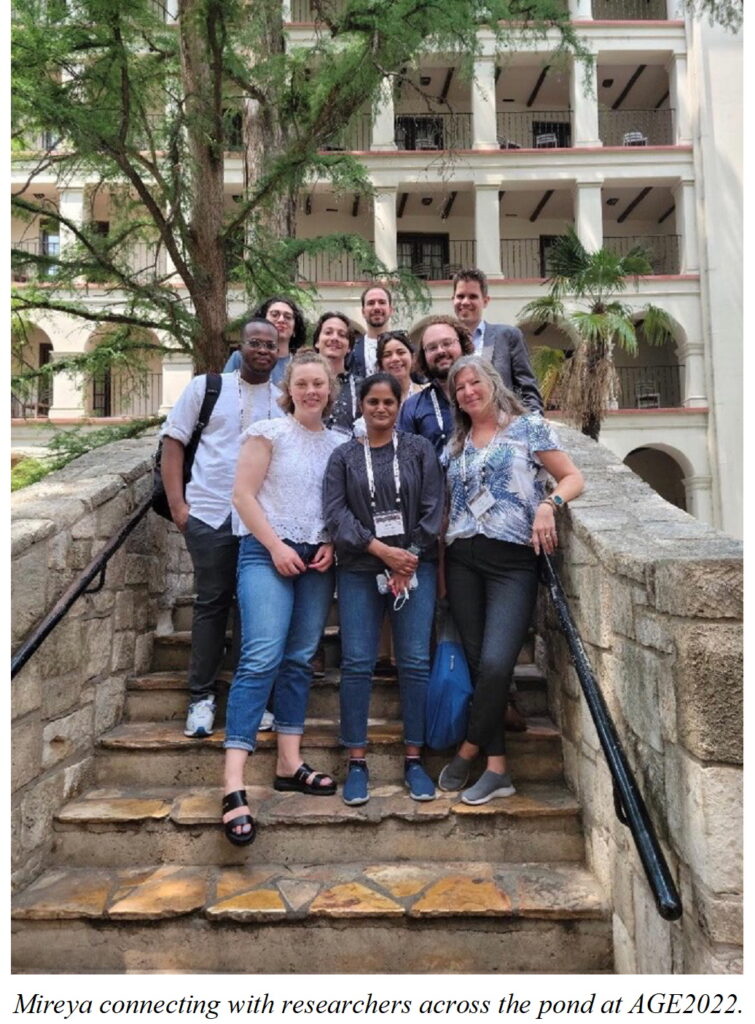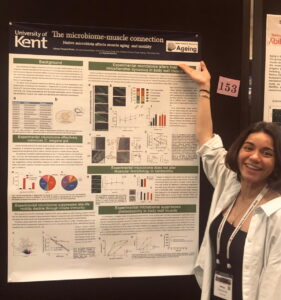By Mireya Vazquez-Prada, winner of the British Society of Research on Ageing Korenchevsky Award 2021
When conferences migrated to cyberspace in 2020, I was initially apprehensive. Conferences are my favourite feature of postgraduate life: a chance to learn of recent breakthroughs and return to the lab brimming with new ideas. Though the British Society of Research on Ageing (BSRA) 2021 Metabolism of Ageing scientific meeting was hosted online, it retained all the best features of an in-person event. I presented my PhD research and got very valuable feedback from the research community. To my surprise I awarded the Korenchevsky Award for best presentation by an early career researcher – to my delight part of the award was to travel to Texas to attend AGE 2022, the annual American Aging Association conference.
 AGE 2022 was a fantastic experience that demonstrated how multifaceted ageing research is – each day of talks highlighted different approaches to ageing. The meeting kicked off with a thought-provoking plenary by Prof. David Gems who challenged the ‘Hallmarks of Aging’ model and called for a return to the fundamental causes of ageing. Prof. Colleen Murphy’s keynote lecture was a personal favourite as she discussed the expanding repertoire of ageing metrics in C. elegans including reproductive and cognitive decline. Dr. Peter Attia spoke on the changing landscape in ageing interventions and ‘Medicine 3.0’ – an age of evidence-informed personalised therapeutics. This are just some brief highlights – here were so many more fascinating speakers!
AGE 2022 was a fantastic experience that demonstrated how multifaceted ageing research is – each day of talks highlighted different approaches to ageing. The meeting kicked off with a thought-provoking plenary by Prof. David Gems who challenged the ‘Hallmarks of Aging’ model and called for a return to the fundamental causes of ageing. Prof. Colleen Murphy’s keynote lecture was a personal favourite as she discussed the expanding repertoire of ageing metrics in C. elegans including reproductive and cognitive decline. Dr. Peter Attia spoke on the changing landscape in ageing interventions and ‘Medicine 3.0’ – an age of evidence-informed personalised therapeutics. This are just some brief highlights – here were so many more fascinating speakers!
At the poster sessions, I enjoyed free-flowing discussions at different levels of granularity. One minute I was in a macroscopic conversation with David Gems on ageing theory and field history, and in the next I was troubleshooting C. elegans respiration with members of the Leiser lab from the University of Michigan.
Needless to say the calibre of research was outstanding. But what made an impression on me was the dynamism, inclusivity, and diversity of the geroscience community. The Women in Aging breakfast was a highlight, featuring compassionate and insightful discussions of the progress women have made in STEM fields, challenges along the way, and the ground we can continue to cover by uplifting one another. AGE 2022 was also notable in its support for early career researchers. The organising committee took great care to provide spaces where post-baccs, PhD students, and postdocs could unreservedly discuss their research.
At the Data Blitz, a series of flash talks by trainees, Dr. Brandon Berry from the Kaeberlein lab presented astounding work on altering mitochondrial membrane potential using optogenetics and using this intervention to extend lifespan in C. elegans. Noting that Dr. Berry’s work sounded very familiar, I realised he was presenting the preprint that I had saved on bioRxiv just a week prior! It was a welcome reminder that the groundbreaking data we celebrate at conferences is made possible by groundbreaking people, and that the quality of our research is vastly improved by a connected community.
The close of AGE 2022 was bittersweet. As sad as it was to leave, I was eager to get back to the bench feeling inspired. I would like to thank the BSRA for the opportunity to attend such an exciting event, set against the backdrop of a beautiful and historic city. Touring the heart of San Antonio in a riverboat, chatting about the Programmatic Theory of Aging with new friends – those memories will be hard to beat!

Mireya Vazquez-Prada is a third-year PhD student at the University of Kent, UK, with undergraduate and Master’s degrees from University College London, UK. In addition to being a scientist, she has a passion for the arts and is a keen art collector. Mireya is the founder of The daVinci Project (davinci-project.com), an online platform for original art inspired by scientific publications. Through this project, Mireya hopes to make groundbreaking science more accessible to the public and foster dialogue between the artistic and research communities.
